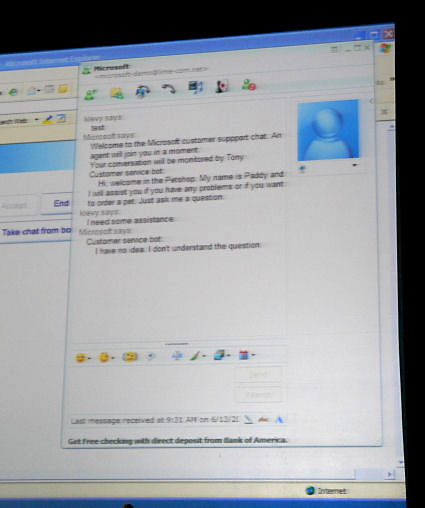TechEd 2006: Lonely? Spend some time with Microsoft's bots.
Boston (MA) - In perhaps the clearest indication at TechEd 2006 that everything old is new again, yesterday, Microsoft demonstrated a new set of APIs that will be compatible with the company's Windows Live Messenger program, that will enable automated services to communicate to users using natural language. They'll conduct conversations with people over IM chats, and may even become friends with their users.
In one example, among the list of entries in a Messenger's list of friends (analogous to what AOL calls "buddies") was the Yellow Pages. A user could call up the Yellow Pages on IM, and ask for an address or phone number using natural language queries. A similar demonstration was performed with Microsoft Encarta, which led a terse, though explanatory, virtual conversation with a user about various statistics on African elephants. Such conversations brought back memories of "Eliza," the semi-natural language communications system that pretended to be a family guidance counselor, that became popular in 1978 on the 4K TRS-80.
Lonely? Try spending some time with everyone's new best friend, the customer service 'bot' at Microsoft.
It isn't quite clear yet how these new conversational "bot" services would be accentuated on Messenger over and above what users would see in a chat room or similar service launched through a Web browser.
Microsoft had a few more interesting examples, what the bot potentially could do, including this one: One bot that Microsoft is developing, perhaps (hopefully) as a demo, sets up a bot that performs customer service for Microsoft. The job of this particular agent, as thoroughly demonstrated here yesterday, appeared to be to pretend to listen attentively to the customer's problem, and then explain why it couldn't understand it. At one point, the bot resorted to Swedish instead of English in attempting a conciliatory explanation.
Microsoft's Ken Levy, who conducted the demo, suggested that a company could use a bot like this to keep customers occupied during the intervals while they're awaiting conversations with real people. But Levy also suggested that companies using such bots also employ people who can monitor these virtual discussions - not unlike the checkout person at the grocery store who monitors the check-out-yourself line - who can monitor the chat, detect when it's starting to go south (the onset of unrequested Swedish could be your first clue), and conduct an intervention to help retain the customer on the line.
Stay in touch with TG Daily for more throughout the week from TechEd 2006 in Boston.
Get Tom's Hardware's best news and in-depth reviews, straight to your inbox.
